Experimental Underperformance Detection of a Fixed-Speed Diesel–Electric Generator Based on Exhaust Gas Emissions
Abstract
1. Introduction
| Phenomena | Signs of Occurrence | Causes/Consequences |
|---|---|---|
| Wet stacking |
| Prolonged engine operation at a low load prevents the temperature from reaching its required value for the complete combustion of all the injected fuel. |
| Polishing cylinder |
| Local mechanical friction is probably due to carbon deposits around the rings caused by poor combustion from running the engine at a low load. |
| Glazing cylinder |
|
|
| Effects |
| |
2. Case of Remote Communities in Northern Canada

3. Experimental Apparatus
4. Methodology
- Exhaust emission characteristics include exhaust gas temperature, SO2, CO2, NOx, O2, CO, and S.
- The effect of Brake-Specific Fuel Consumption (BSFC)
5. Results and Discussion
5.1. Engine Performance: Brake Specific Fuel Consumption (BSFC)
5.2. Exhaust Gas Temperature
5.3. Sulfur Emissions (S)
5.4. Sulfur Dioxide Emissions (SO2)
5.5. Oxygen Emissions (O2)
5.6. Carbon Monoxide Emissions (CO)
5.7. Nitrogen Oxide Emissions (NOx)
5.8. Carbon Dioxide Emissions (CO2)
6. Conclusions
- Very low load.
- Low load.
- Medium load.
- According to data analysis, it is found that under a very low load (0–25%), the exhaust gas temperature does not exceed 190 °C for an extended period of operation (up to 2 h), while under a 30% load, the temperature stabilizes at 220 °C; this is true for both regimes (extended period and not extended period). Therefore, it was concluded that the exhaust gas temperature could be used as an index of underperformance operation if prolonged operation time under low load is associated.
- The BSFC showed an increase when the diesel–electric generator was subjected to a light load (≤30%) for a prolonged duration (up to 2 h) versus a short period (15 min). It recorded a 6.4 gallons/kWh consumption in underperformance operation at 30% of the applied load versus 6.14 gallons/kWh in normal operation. However, the BSFC returns to normal when the load attains 40% and registers 8.5 gallons/kWh. Based on the results obtained, the BSFC can be considered an underperformance index.
- Analysis of gas emissions such as carbon monoxide and sulfur dioxide emissions have been discarded. This could be explained by the fact that some emission values are similar under low and normal loads.
- Carbon dioxide emissions, nitrogen oxide emissions, and sulfur showed an increase in their levels when the generator was subjected to low load (≤30%) for a prolonged period (up to two hours) associated with underperformance operation. These gases tend to reach a normal emission level when the applied load increases to 40%. It was found that carbon dioxide emissions increase up to 0.5% under very-low and low loads (0–30%), nitrogen oxide emissions by up to 10 ppm, and sulfur by 2 ppm.
- Finally, unlike all other gases, oxygen emissions decrease under very-low and low loads by up to 2% before reaching the normal level of emissions under a normal load (40% and above). This allows us to conclude that oxygen can be also considered an underperformance index.
Author Contributions
Funding
Data Availability Statement
Conflicts of Interest
References
- Abedin, M.J.; Imran, A.; Masjuki, H.H.; Kalam, M.A.; Shahir, S.A.; Varman, M.; Ruhul, A.M. An overview on comparative engine performance and emission characteristics of different techniques involved in diesel engine as dual-fuel engine operation. Renew. Sustain. Energy Rev. 2016, 60, 306–316. [Google Scholar] [CrossRef]
- Buyukkaya, E. Effects of biodiesel on a DI diesel engine performance, emission and combustion characteristics. Fuel 2010, 89, 3099–3105. [Google Scholar] [CrossRef]
- Ibrahim, H.; Issa, M.; Lepage, R.; Ilinca, A.; Perron, J. Supercharging of diesel engine with compressed air: Experimental investigation on greenhouse gases and performance for a hybrid wind-diesel system. Smart Grid Renew. Energy 2019, 10, 213. [Google Scholar] [CrossRef]
- Wang, B.L.; Lee, C.W.; Reitz, R.D.; Miles, P.C.; Han, Z. A generalized renormalization group turbulence model and its application to a light-duty diesel engine operating in a low-temperature combustion regime. Int. J. Engine Res. 2013, 14, 279–292. [Google Scholar] [CrossRef]
- Issa, M.; Rezkallah, M.; Ilinca, A.; Ibrahim, H. Grid integrated non-renewable based hybrid systems: Control strategies, optimization, and modeling. In Hybrid Technologies for Power Generation; Academic Press: Cambridge, MA, USA; Elsevier: Amsterdam, The Netherlands, 2022; pp. 101–135. [Google Scholar]
- Issa, M.; Ibrahim, H.; Ilinca, A.; Hayyani, M.Y. A review and economic analysis of different emission reduction techniques for marine diesel engines. Open J. Mar. Sci. 2019, 9, 148. [Google Scholar] [CrossRef]
- Issa, M.; Ilinca, A.; Martini, F. Ship Energy Efficiency and Maritime Sector Initiatives to Reduce Carbon Emissions. Energies 2022, 15, 7910. [Google Scholar] [CrossRef]
- Fayad, A.; Ibrahim, H.; Ilinca, A.; Sattarpanah Karganroudi, S.; Issa, M. Energy Recovering Using Regenerative Braking in Diesel–Electric Passenger Trains: Economical and Technical Analysis of Fuel Savings and GHG Emission Reductions. Energies 2021, 15, 37. [Google Scholar] [CrossRef]
- Barbosa, R.; Issa, M.; Silva, S.; Ilinca, A. Variable Speed Diesel Electric Generators: Technologies, Benefits, Limitations, Impact on Greenhouse Gases Emissions and Fuel Efficiency. J. Energy Power Technol. 2022, 4, 3. [Google Scholar] [CrossRef]
- James, C.J. Analysis of Parasitic Losses in Heavy Duty Diesel Engines. Doctoral Dissertation, Massachusetts Institute of Technology, Cambridge, MA, USA, 2012. [Google Scholar]
- Yang, B.; Xi, C.; Wei, X.; Zeng, K.; Lai, M.C. Parametric investigation of natural gas port injection and diesel pilot injection on the combustion and emissions of a turbocharged common rail dual-fuel engine at low load. Appl. Energy 2015, 143, 130–137. [Google Scholar] [CrossRef]
- Duan, X.; Liu, Y.; Liu, J.; Lai, M.C.; Jansons, M.; Guo, G.; Zhang, S.; Tang, Q. Experimental and numerical investigation of the effects of low-pressure, high-pressure and internal EGR configurations on the performance, combustion and emission characteristics in a hydrogen-enriched heavy-duty lean-burn natural gas SI engine. Energy Convers. Manag. 2019, 195, 1319–1333. [Google Scholar] [CrossRef]
- Yousefi, A.; Guo, H.; Birouk, M. An experimental and numerical study on diesel injection split of a natural gas/diesel dual-fuel engine at a low engine load. Fuel 2018, 212, 332–346. [Google Scholar] [CrossRef]
- Wei, L.; Geng, P. A review on natural gas/diesel dual fuel combustion, emissions and performance. Fuel Process. Technol. 2016, 142, 264–278. [Google Scholar] [CrossRef]
- Rao, X.; Sheng, C.; Guo, Z.; Yuan, C. A review of online condition monitoring and maintenance strategy for cylinder liner-piston rings of diesel engines. Mech. Syst. Signal Process. 2022, 165, 108385. [Google Scholar] [CrossRef]
- Bao, J.; Wang, H.; Wang, R.; Wang, Q.; Di, L.; Shi, C. Comparative Experimental Study on Macroscopic Spray Characteristics of Various Oxygenated Diesel Fuels. Energy Sci. Eng. 2023. [Google Scholar] [CrossRef]
- Shi, C.; Chai, S.; Di, L.; Ji, C.; Ge, Y.; Wang, H. Combined experimental-numerical analysis of hydrogen as a combustion enhancer applied to Wankel engine. Energy 2023, 263, 125896. [Google Scholar] [CrossRef]
- Abbas, T.; Issa, M.; Ilinca, A. Biomass cogeneration technologies: A review. J. Sustain. Bioenergy Syst. 2020, 10, 1–15. [Google Scholar] [CrossRef]
- Issa, M.; Fiset, J.; Mobarra, M.; Ibrahim, H.; Ilinca, A. Optimizing the performance of a 500 kW Diesel Generator: Impact of the Eo-Synchro concept on fuel consumption and greenhouse gases. Power Eng. 2018, 23, 22–31. [Google Scholar]
- Bao, J.; Qu, P.; Wang, H.; Zhou, C.; Zhang, L.; Shi, C. Implementation of various bowl designs in an HPDI natural gas engine focused on performance and pollutant emissions. Chemosphere 2022, 303, 135275. [Google Scholar] [CrossRef]
- Chen, Y.; Feng, L.; Mansir, I.B.; Taghavi, M.; Sharma, K. A new coupled energy system consisting of fuel cell, solar thermal collector, and organic Rankine cycle; generation and storing of electrical energy. Sustain. Cities Soc. 2022, 81, 103824. [Google Scholar] [CrossRef]
- Pereyra-Mariñez, C.; Andrickson-Mora, J.; Ocaña-Guevera, V.S.; Santos García, F.; Vallejo Diaz, A. Energy Supply Systems Predicting Model for the Integration of Long-Term Energy Planning Variables with Sustainable Livelihoods Approach in Remote Communities. Energies 2023, 16, 3143. [Google Scholar] [CrossRef]
- Issa, M. Optimisation Opérationnelle, Écologique et Énergétique des Groupes Électrogènes Diesel. Ph.D. Thesis, Université du Québec à Rimouski, Rimouski, QC, Canada, 2020. [Google Scholar]
- Issa, M.; Ibrahim, H.; Lepage, R.; Ilinca, A. A review and comparison on recent optimization methodologies for diesel engines and diesel power generators. J. Power Energy Eng. 2019, 7, 31. [Google Scholar] [CrossRef]
- Rehman, S. Hybrid power systems–Sizes, efficiencies, and economics. Energy Explor. Exploit. 2021, 39, 3–43. [Google Scholar] [CrossRef]
- Arriaga, M.; Cañizares, C.A.; Kazerani, M. Northern lights: Access to electricity in Canada’s northern and remote communities. IEEE Power Energy Mag. 2014, 12, 50–59. [Google Scholar] [CrossRef]
- Froese, S.; Kunz, N.C.; Ramana, M. Too small to be viable? The potential market for small modular reactors in mining and remote communities in Canada. Energy Policy 2020, 144, 111587. [Google Scholar] [CrossRef]
- Katiraei, F.; Abbey, C. Diesel plant sizing and performance analysis of a remote wind-diesel microgrid. In Proceedings of the 2007 IEEE Power Engineering Society General Meeting, Tampa, FL, USA, 24–28 June 2007; pp. 1–8. [Google Scholar]
- McFarlan, A. Techno-economic assessment of pathways for electricity generation in northern remote communities in Canada using methanol and dimethyl ether to replace diesel. Renew. Sustain. Energy Rev. 2018, 90, 863–876. [Google Scholar] [CrossRef]
- Mobarra, M.; Rezkallah, M.; Ilinca, A. Variable Speed Diesel Generators: Performance and Characteristic Comparison. Energies 2022, 15, 592. [Google Scholar] [CrossRef]
- Sedaghat, B.; Jalilvand, A.; Noroozian, R. Design of a multilevel control strategy for integration of stand-alone wind/diesel system. Int. J. Electr. Power Energy Syst. 2012, 35, 123–137. [Google Scholar] [CrossRef]
- Issa, M.; Ibrahim, H.; Hosni, H.; Ilinca, A.; Rezkallah, M. Effects of low charge and environmental conditions on diesel generators operation. Eng 2020, 1, 137–152. [Google Scholar] [CrossRef]
- Jabeck, B. The Impact of Generator Set Underloading (Caterpillar). Available online: https://www.cat.com/en_US/by-industry/electric-power/Articles/White-papers/the-impact-of-generator-set-underloading.html (accessed on 1 February 2022).
- Tufte, E.D. Impacts of Low Load Operation of Modern Four-Stroke Diesel Engines in Generator Configuration. Master’s Dissertation, Institutt for Marin Teknikk, Trondheim, Norway, 2014. [Google Scholar]
- Hamilton, J.; Negnevitsky, M.; Wang, X. Low load diesel perceptions and practices within remote area power systems. In Proceedings of the 2015 International Symposium on Smart Electric Distribution Systems and Technologies (EDST), Vienna, Austria, 8–11 September 2015; pp. 121–126. [Google Scholar]
- Mustayen, A.; Rasul, M.; Wang, X.; Negnevitsky, M.; Hamilton, J. Remote areas and islands power generation: A review on diesel engine performance and emission improvement techniques. Energy Convers. Manag. 2022, 260, 115614. [Google Scholar] [CrossRef]
- Mustayen, A.; Wang, X.; Rasul, M.; Hamilton, J.; Negnevitsky, M. Theoretical investigation of combustion and performance analysis of diesel engine under low load conditions. IOP Conf. Ser. Earth Environ. Sci. 2021, 838, 012013. [Google Scholar] [CrossRef]
- Saiyasitpanich, P.; Lu, M.; Keener, T.C.; Liang, F.; Khang, S.-J. The effect of diesel fuel sulfur content on particulate matter emissions for a nonroad diesel generator. J. Air Waste Manag. Assoc. 2005, 55, 993–998. [Google Scholar] [CrossRef] [PubMed]
- Penny, M.A.; Jacobs, T.J. Efficiency improvements with low heat rejection concepts applied to diesel low temperature combustion. Int. J. Engine Res. 2016, 17, 631–645. [Google Scholar] [CrossRef]
- German-Galkin, S.; Tarnapowicz, D.; Matuszak, Z.; Jaskiewicz, M. Optimization to limit the effects of underloaded generator sets in stand-alone hybrid ship grids. Energies 2020, 13, 708. [Google Scholar] [CrossRef]
- Ayodele, T.; Ogunjuyigbe, A.; Akinola, O. n-split generator model: An approach to reducing fuel consumption, LCC, CO2 emission and dump energy in a captive power environment. Sustain. Prod. Consum. 2017, 12, 193–205. [Google Scholar] [CrossRef]
- Ferrier, L.; Ibrahim, H.; Issa, M.; Ilinca, A. State of the Art of Telecommunication Systems in Isolated and Constrained Areas. Sensors 2021, 21, 3073. [Google Scholar] [CrossRef] [PubMed]
- Testo. Testo 350—Portable Emission Analyzer. Available online: https://www.testo.com/en-US/testo-350/p/0632-3510 (accessed on 1 February 2023).
- Government of Canada. Consultations on Potential Amendments to Sulphur in Diesel Fuel Regulations—Compendium of Stakeholder Comments. 2006. Available online: https://www.canada.ca/en/environment-climate-change/services/canadian-environmental-protection-act-registry/sulphur-diesel-fuel-regulations-consultations.html (accessed on 19 October 2022).
- ISO 3046-1:2002; Reciprocating Internal Combustion Engines—Performance—Part 1: Declarations of Power, Fuel and Lubricating Oil Consumptions, and Test Methods—Additional Requirements for Engines for General Use. International Organization for Standardization: Geneva, Switzerland, 2002. Available online: https://www.iso.org/obp/ui/#iso:std:iso:3046:-1:ed-5:v1:en (accessed on 19 October 2022).
- Fahd, M.E.A.; Wenming, Y.; Lee, P.; Chou, S.; Yap, C.R. Experimental investigation of the performance and emission characteristics of direct injection diesel engine by water emulsion diesel under varying engine load condition. Appl. Energy 2013, 102, 1042–1049. [Google Scholar] [CrossRef]
- Ghobadian, B.; Yusaf, T.; Najafi, G.; Khatamifar, M. Diesterol: An environment-friendly IC engine fuel. Renew. Energy 2009, 34, 335–342. [Google Scholar]
- Agarwal, A.K.; Srivastava, D.K.; Dhar, A.; Maurya, R.K.; Shukla, P.C.; Singh, A.P. Effect of fuel injection timing and pressure on combustion, emissions and performance characteristics of a single cylinder diesel engine. Fuel 2013, 111, 374–383. [Google Scholar] [CrossRef]
- Liu, Y.; Peng, L.; Ngo, H.H.; Guo, W.; Wang, D.; Pan, Y.; Sun, J.; Ni, B.J. Evaluation of nitrous oxide emission from sulfide-and sulfur-based autotrophic denitrification processes. Environ. Sci. Technol. 2016, 50, 9407–9415. [Google Scholar] [CrossRef]
- Jha, P.R.; Partridge, K.R.; Krishnan, S.R.; Srinivasan, K.K. Impact of low reactivity fuel type on low load combustion, emissions, and cyclic variations of diesel-ignited dual fuel combustion. Int. J. Engine Res. 2023, 24, 42–63. [Google Scholar] [CrossRef]
- Li, T.; Suzuki, M.; Ogawa, H. Effect of two-stage injection on unburned hydrocarbon and carbon monoxide emissions in smokeless low-temperature diesel combustion with ultra-high exhaust gas recirculation. Int. J. Engine Res. 2010, 11, 345–354. [Google Scholar] [CrossRef]
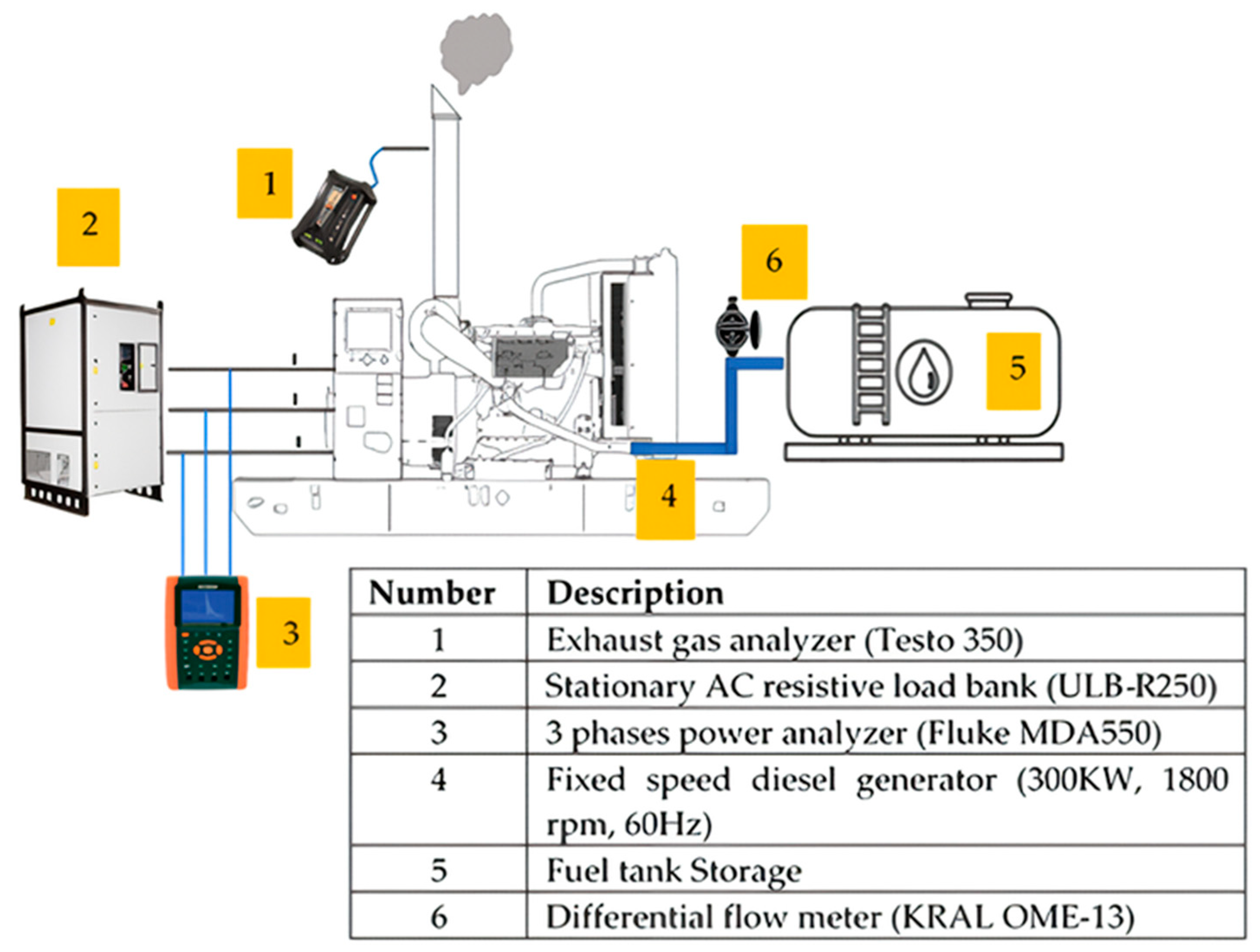


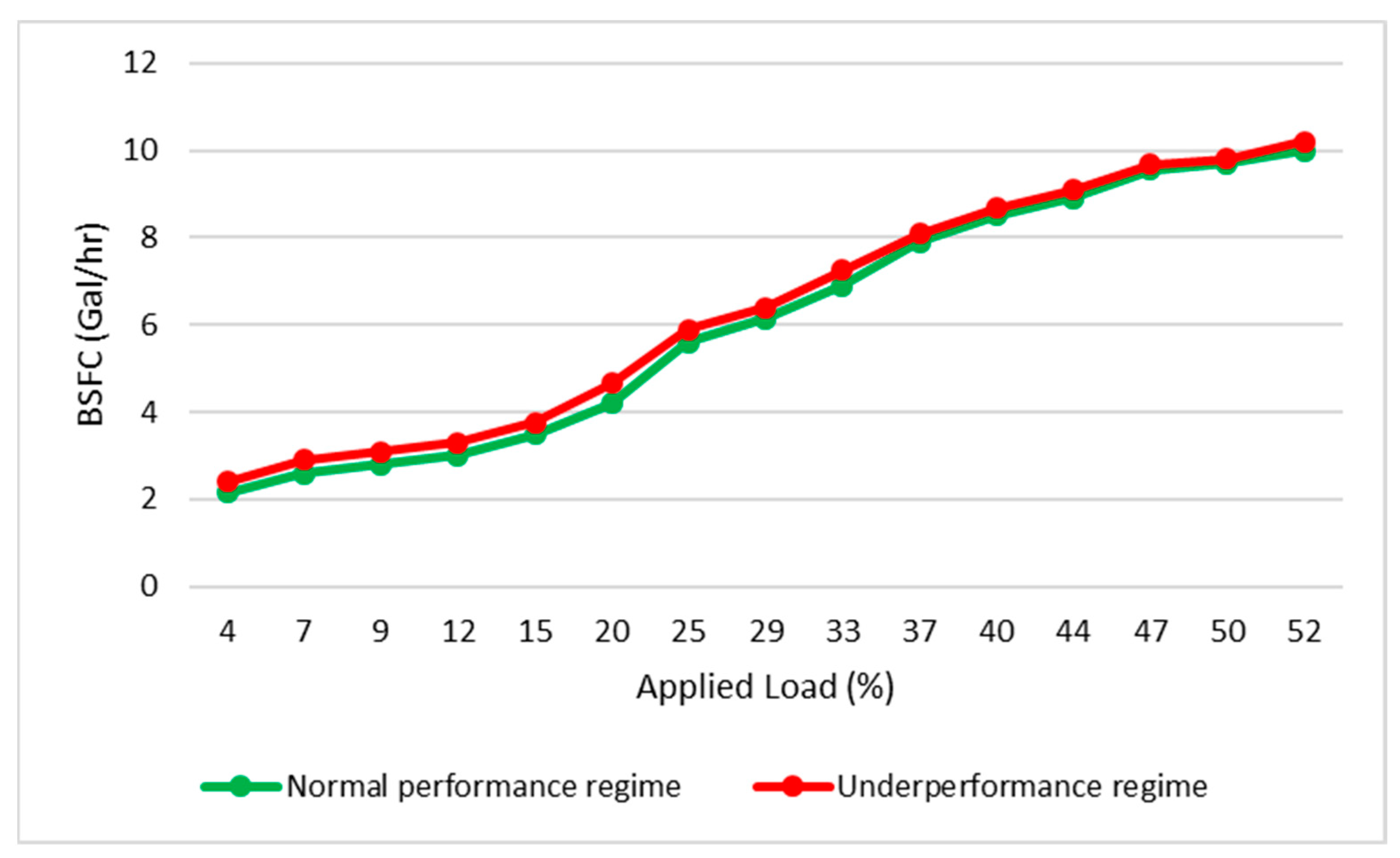
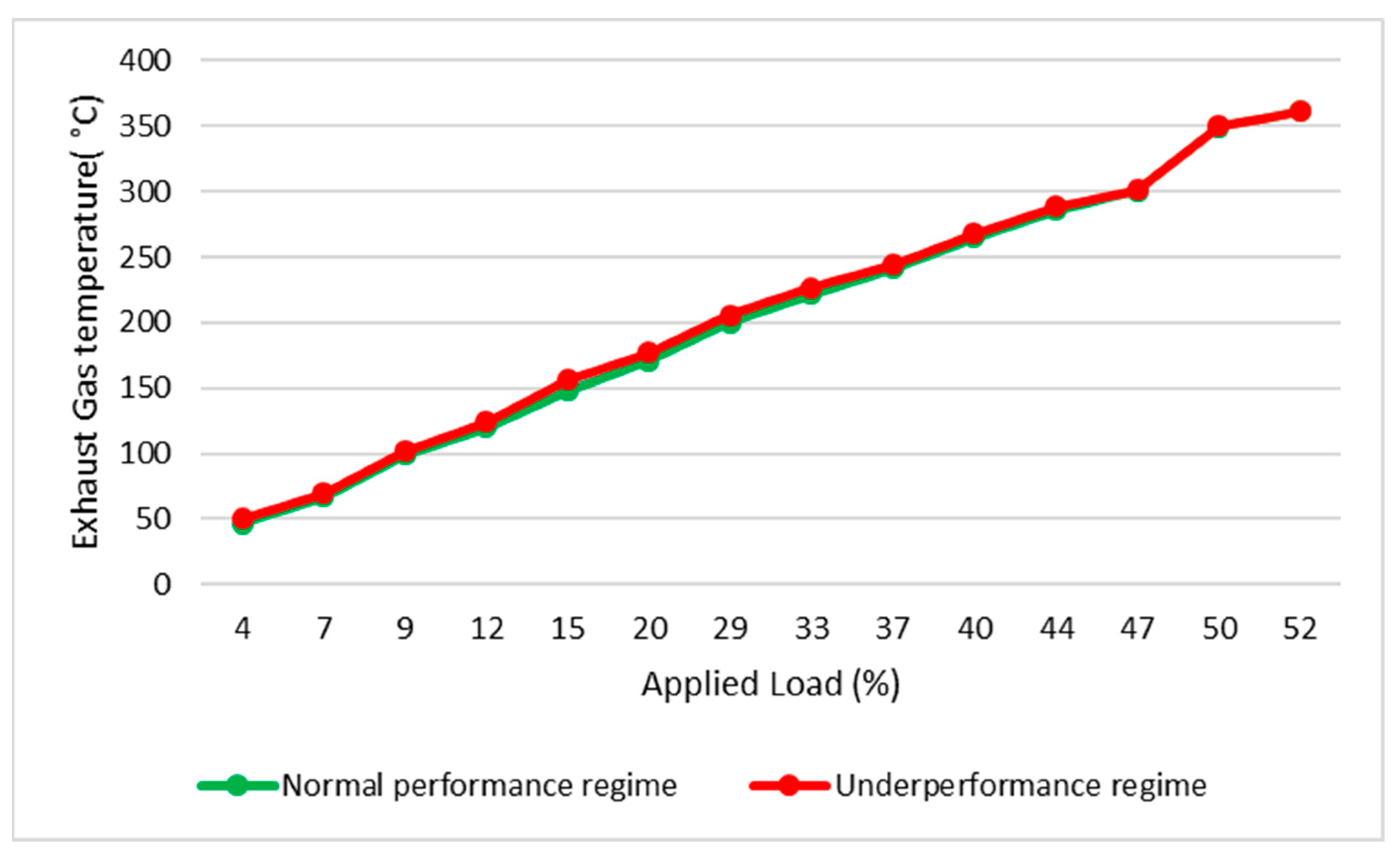

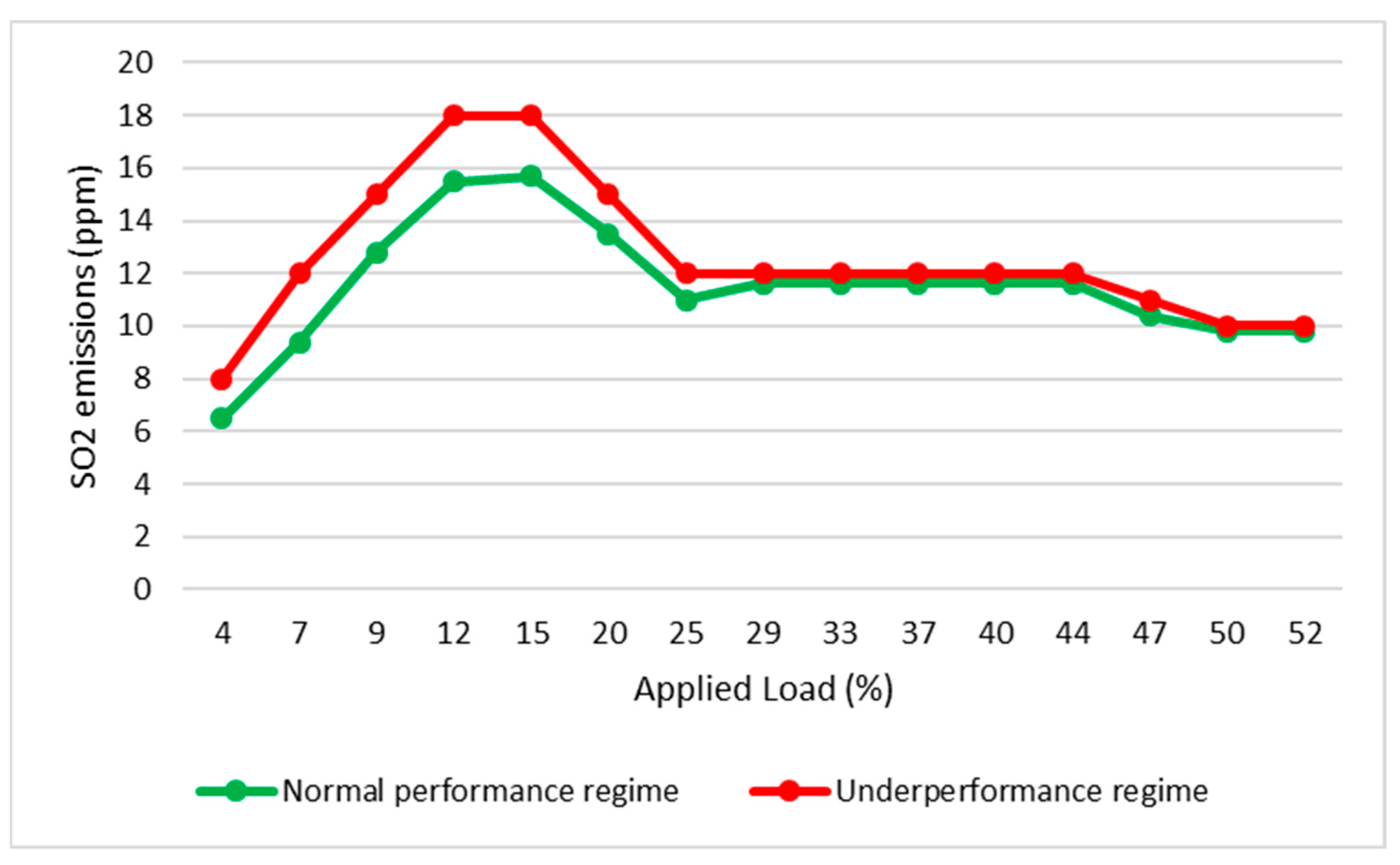
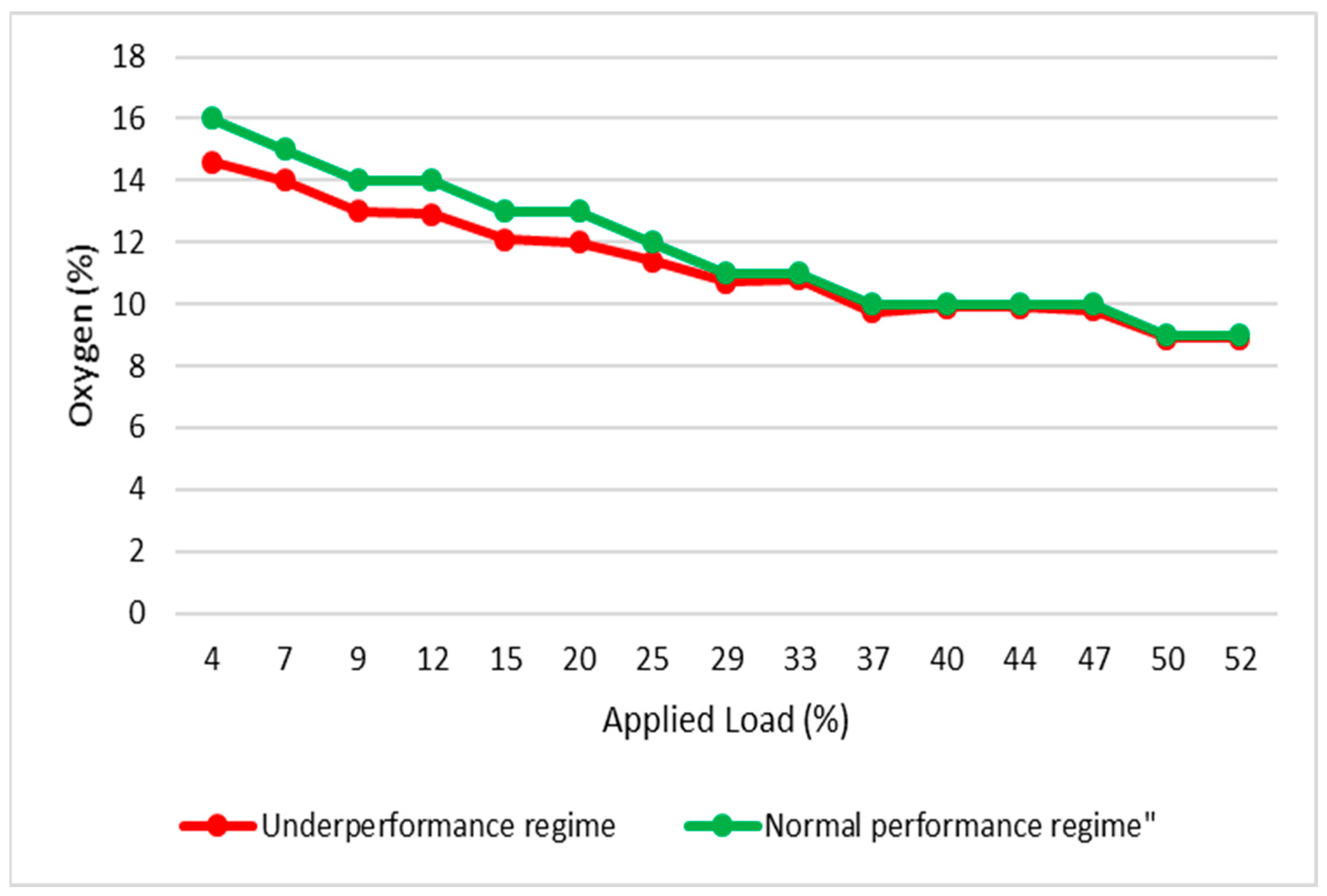
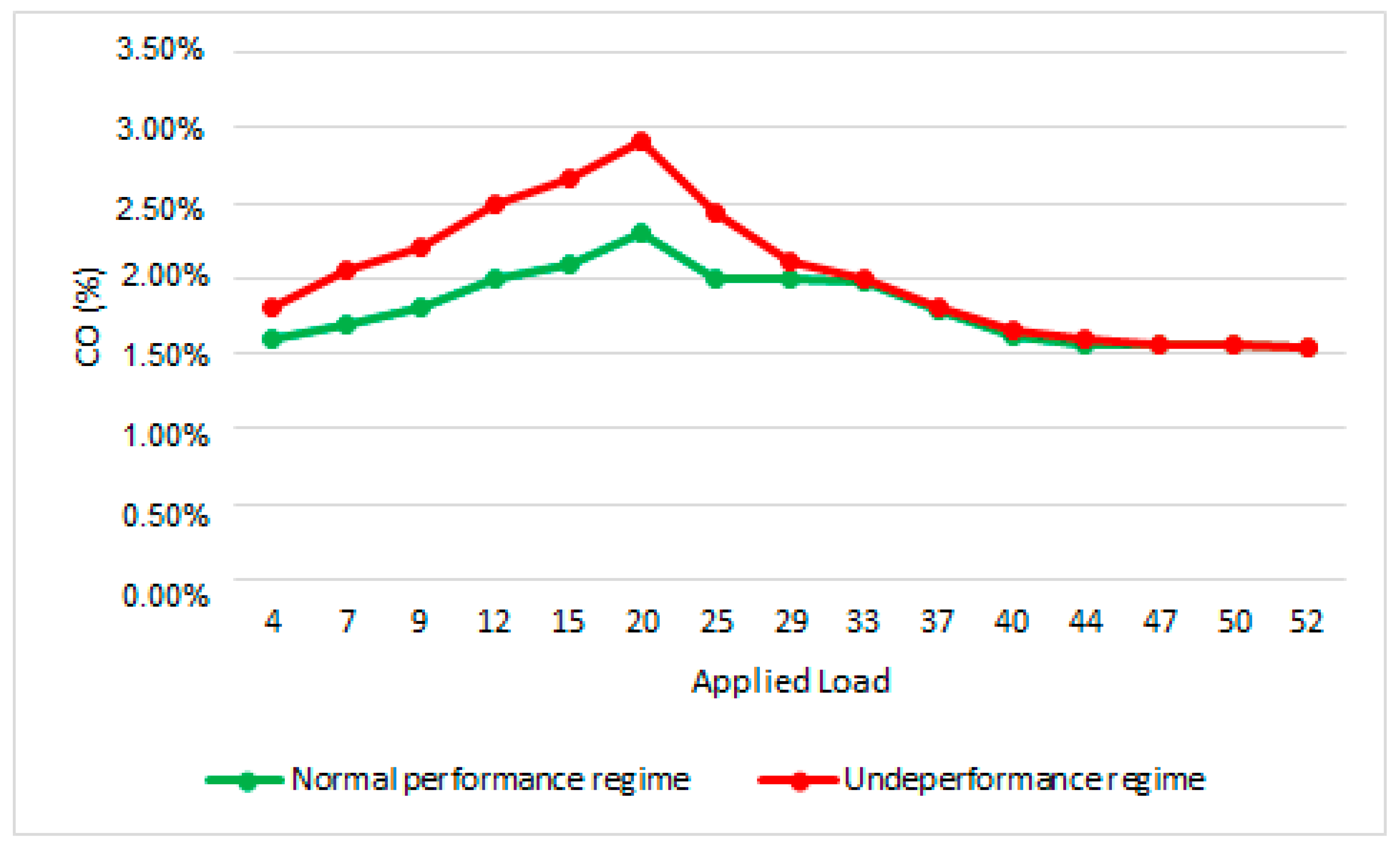


| Power Percentage | Load Level |
|---|---|
| 0–25% | Very low load |
| 26–39% | Low load |
| 40–80% | Regular load |
| 81–90% | High load |
| 91–100% | Very high load |
| Engine Type | Inline Six Cylinders, C9 |
| Bore | 112.0 mm |
| Stroke | 149.1 mm |
| Displacement | 8.8 L |
| Compression Ratio | 16.1:1 |
| Aspiration | Air to air aftercooled |
| Fuel system | Hydraulic electronic unit injection |
| Governor type | Adem A4 |
| Standby Rating | 300 ekW |
| Alternator design | Brushless single bearing, 4-pole |
| Stator | 2/3 Pitch |
| No. of Leads | 12 |
| Voltage | 208 V |
| Frequency | 60 Hz |
| Voltage regulation, steady state +/− | ≤0.5% |
| Flue Gas | Measuring Range | Accuracy | Resolution |
|---|---|---|---|
| CO2 | 0 to CO2 max | calculated from O2 ±0.2 Vol.% | 0.01 Vol.% |
| O2 | 0 to +25 Vol.% | ±0.8% of fsv (0 to +25 Vol.%) | 0.01 Vol.% (0 to +25 Vol.%) |
| CO | 0 to +10,000 ppm | ±5 % of mv (+200 to +2000 ppm) ±10 % of mv (+2001 to +10,000 ppm) ±10 ppm (0 to +199 ppm) | 1 ppm (0 to +10,000 ppm) |
| NO | 0 to +4000 ppm | ±5 % of mv (+100 to +1999 ppm) ±10 % of mv (+2000 to +4000 ppm) ±5 ppm (0 to +99 ppm) | 1 ppm (0 to +4000 ppm) |
| NOX | 0 to +500 ppm | ±5 % of mv (+100 to +2000 ppm) ±10 % of mv (+2001 to +5000 ppm) ±5 ppm (0 to +99 ppm) | 1 ppm (0 to +5000 ppm) |
| SOX | 0 to +5000 ppm | ±5 % of mv (+100 to +2000 ppm) ±10 % of mv (+2001 to +5000 ppm) ±5 ppm (0 to +99 ppm) | 1 ppm (0 to +5000 ppm) |
Disclaimer/Publisher’s Note: The statements, opinions and data contained in all publications are solely those of the individual author(s) and contributor(s) and not of MDPI and/or the editor(s). MDPI and/or the editor(s) disclaim responsibility for any injury to people or property resulting from any ideas, methods, instructions or products referred to in the content. |
© 2023 by the authors. Licensee MDPI, Basel, Switzerland. This article is an open access article distributed under the terms and conditions of the Creative Commons Attribution (CC BY) license (https://creativecommons.org/licenses/by/4.0/).
Share and Cite
Ghorbanzadeh, M.; Issa, M.; Ilinca, A. Experimental Underperformance Detection of a Fixed-Speed Diesel–Electric Generator Based on Exhaust Gas Emissions. Energies 2023, 16, 3537. https://doi.org/10.3390/en16083537
Ghorbanzadeh M, Issa M, Ilinca A. Experimental Underperformance Detection of a Fixed-Speed Diesel–Electric Generator Based on Exhaust Gas Emissions. Energies. 2023; 16(8):3537. https://doi.org/10.3390/en16083537
Chicago/Turabian StyleGhorbanzadeh, Milad, Mohamad Issa, and Adrian Ilinca. 2023. "Experimental Underperformance Detection of a Fixed-Speed Diesel–Electric Generator Based on Exhaust Gas Emissions" Energies 16, no. 8: 3537. https://doi.org/10.3390/en16083537
APA StyleGhorbanzadeh, M., Issa, M., & Ilinca, A. (2023). Experimental Underperformance Detection of a Fixed-Speed Diesel–Electric Generator Based on Exhaust Gas Emissions. Energies, 16(8), 3537. https://doi.org/10.3390/en16083537









